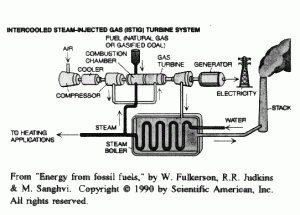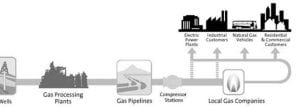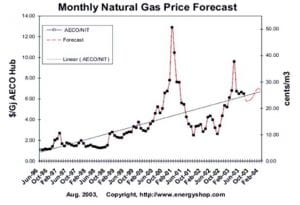The information on this page was prepared by:
| Megan Page | mpage@usc.edu | Computer Engineering |
| Laveena Rajan | lrajan@usc.edu | Chemical Engineering |
Natural Gas: Extraction and Delivery
Natural Gas Extraction and Delivery
Firstly, wells are drilled into the porous rock and pipes are used to bring the natural gas to the surface. From there, it goes to gas processing plants which remove impurities that might corrode a pipeline. Hundreds of miles of underground pipelines then transport the gas thousands of miles from producing regions to local natural gas distribution centers. Local distribution companies measure the gas and ass a sour-smelling odorant to it in order for customers to smell small quantities of gas in case of a leak. Gas is then further distributed to households and business through main pipelines. Compressor stations move gas through the whole system, and different kinds of gas storage facilities and peaking facilities supplement gas supply on cold days. The figure below shows how natural gas gets to market.
It is important to mention here that advancing technologies with the natural gas delivery system are helping to make it even more efficient. Of these technologies are the ultra quiet new pipeline compressors and the plastic pipe that can function under high pressures, thereby reducing the need for new pipe.
Inter-cooled Steam Gas Turbine System
The gas turbine captures heat from the turbine to produce steam. The steam is channeled to the combustion chamber. At the same time the combustion air is cooled during compression. Diversion of air from the compressor unit to the turbine blades cools them, enabling them to withstand higher gas temps.
Delivery System
System includes the following: production wells, processing plants to remove impurities, underground pipelines and smaller local distribution lines, compressor stations to move gas through the system, different kinds of gas storage facilities and peaking facilities to supplement gas supply on cold days. New technological advances with natural gas delivery system include the ultra quiet new pipeline compressors and the plastic pipe that can operate under high pressures which would reduce the need for new pipe.
How Natural Gas Gets to Market
- Wells are drilled into the porous rock and pipes are used to bring the natural gas to the surface.
- Gas processing plant removes impurities that might corrode a pipeline.
- Hundreds of miles of pipelines transport natural gas thousands of miles from producing regions to local natural gas utilities.
- Local Distribution companies are where the meters measure the gas and where a sour-smelling odorant is added to help customers smell even small quantities of natural gas. Gas is then distributed to households and business through main pipelines.

